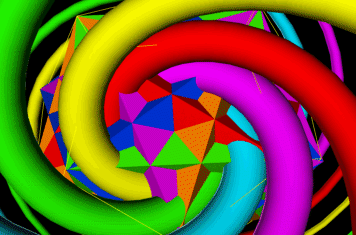From the Inner Sanctum of Doctor Strange
My young friend Russell was recently asking me about the changes in
brain chemistry that accompany death. He wanted to know if it could be
compared to a DMT-like kundalini experience. With a sigh, I had to tell him
that, while death could be the biggest DMT rush of all, for most humans it
was far more likely to be a bad, out-of-focus horror movie.
Since Russell considers me somewhat of an expert on both death and
neuro-chemistry, he insisted that I share my insights. Perhaps I should
begin by qualifying my expert witness status.
In the spring of 1978, I participated in a clinical near-death
simulation study at Duke University Medical School. I was not a researcher,
I was a test subject. Along with a dozen or so other people, I was injected
with a massive dose of a central nervous system depressant, (the same thing
they use as part of the lethal cocktail so popular at modern executions)
allowed to go almost to the point of no-return and then shot up with a
saline and adrenal speedball to the heart that hauled my spirit right back
from where ever it had gone. All I had to do in return for this
roller-coaster ride on the astral plane was to let the lab coat gang
monitor, test and interview me. I think we all got a lot out of it.
Years later, I met and became friends with a man who had truly
died, been declared clinically dead a good ten minutes and without oxygen
to his brain for over twenty minutes. He returned a totally changed being.
Not from brain damage, as one might expect. My friend returned from death
with his mind enhanced.
This curious fact, and my reaction to it, led, by a very long and
complex series of interconnected ideas/events, to this article. Part of
that complex series of events has been my work as a psycho-acoustic
therapist treating PTSD, MPD, dis-associational disorders,
gender-dysfunction, sexual addiction, phobias and compulsions, depression,
anxiety, and all the other emotional fall-out accrued by survivors of
severe childhood abuse. One of the major findings, clinically, of this kind
of work has been the identification of serious bio-chemical and bio-neural
damage caused by severe abuse. (See September ’97 issue of JAMA for the
article.) Through my work with light and sound frequency entrainment of the
brain, I have found that changes in neuro-chemistry can be taught as a
sophisticated form of bio-feedback.
As I worked with this developing technology, I was guided by
something my friend and I had discussed at great length: the passage from
dying to dead. The process of death itself has several clearly defined
stages. In the hospital setting of my experience, the initial phases were
simple and painless. I just laid back and closed my eyes. And then I fell
asleep while still sharply alert.
My friend had his beloved pick-up truck fall on him crushing the
air and the life out of his body. He remained alert allright, but there the
similarities ended. He experienced the whole range of body-death, a kind of
transitional period where the body runs through its defenses and life
saving stratagems. He even felt the moment his brain stopped firing, as he
called it, as he used up the last of the oxygen in his blood. Beyond that,
he was focused on not giving up.
Here however, the similarities are more important than the
differences. As Gurdjieff said, it’s all a matter of focus. Both of us were
focused on staying conscious, which is really to say that we were intent on
maintaining a self-reflexive, self-referencing awareness. I had the easier
task of it, since I could feel confident of coming back. My friend was
actually dying. However, as Tolstoy noted, there is nothing like the
immediate presence of death to sharpen the mind.
While I drifted leisurely up through a vast space containing every
detail of my life and all my past lives stretching back in an infinite
regression of images, my friend was projected like a white hot bullet of
consciousness through a brilliantly colored miasma full of hologramic
recollections of his life’s events. My friend was never able to separate
the passage from its contents, that is he experienced the colors and the
recall as undifferentiated. I was able to experience them as a sequence in
which the recall was clearly prior to the realm of unearthly colors, my
label for that state.
This lack of differentiation was perhaps heightened by the fact
that my friend continued on through the realm of colors and arrived, if we
can think of it that way, at a point of direct encounter with Mind —
capital very much intended. My experience was terminated in the
intermediary realm of color. Nevertheless, comparisons are valuable, and
much can be learned by focusing on this transitional stage. The Tibetans,
after all, have filled libraries with texts exploring the Bardo realms.
As my friend and I discussed these states, I asked if he thought
that working through this process during life would facilitate a person’s
passage through the death zone. He agreed that it could only help, and so I
started thinking of therapy as pre-death training for a good transition.
That was a fine premise, I discovered, from which to explore the mind’s
dysfunction as a whole.
To grok this, we must try to get a little clarity in our thinking
about thinking. In the personal sense, mind is derived from the
electro-chemical processes in the brain. But in an impersonal sense, there
must be some quality of mind that exists separate from the brain’s
structures. My friend died and returned with enhanced mental functions and
crystal clear recall of the experience, proving that something, some mind,
existed in that state to perceive and remember.
In the personal brain/mind complex, consciousness is mediated by
the interaction of electrical impulses and neurotransmitter activated
buffers and filters. Memory is stored hologramically throughout the brain
and is retrieved by a process of broad-band neurotransmitter stimulation.
Therefore, we can think of the continuity of consciousness, which is based
on the density of memory interconnections or the mind’s “temporal
bandwidth,” as a self-generating, self-regulating electro-magnetic field
potential modulated by the action of conductivity sensitive chemicals in
the spark gap of the synapses.
Immortality then becomes a simple matter of creating a
non-dissipative structural resonance with that flow of Mind which appears
to be the substance of reality itself. The in-between state, the Bardo, is
designed to process the un-shareable experiences of a lifetime of
“suffering and attachment,” as the Buddhist puts it. Acceptance and
self-forgiveness, that is re-membering all the parts of a life, good and
bad, leads to a point of shareablity, an increased temporal bandwidth, in
which immortality becomes a simple matter of focus. I exist, therefore I
exist, or, rather, I am, so that I am.
In the brain, focus is triggered by a complex set of
neurotransmitters related to serotonin. As we die, as long we are calm,
open-minded and alert, serotonin production, along with dopamine,
acetylcholine and other neurotransmitters, spikes sharply. By paying
attention to the process of death itself, we can create a feedback loop of
positive, transition enhancing neuro-chemicals. This requirement for a good
death would seem to be main reason why Hospice care works so well. Good
deaths require a minimum of pain and fear, and a maximum of alertness,
attention and compassion.
On the same level, a good transition, of any kind, requires the
same neuro-physiological changes as death, just not to that extreme.
Meditation, of all kinds, begins with learning how to be open and calm and
alert, therefore triggering an increased flow of serotonin to the synapse.
A good chi-filled diet allows us to hold on to these important
neuro-chemicals longer. Enlightenment itself, in the sense of increased
kundalini/neuro-electric activity in the brain, may in fact be a
crystallization of a feedback loop of positive serotonin/melatonin
stimulation. Neurologically, this is indeed similar to the
light-bulb-in-the-brain effect of DMT.
While there is no simple answer to Russell’s question, there are
indeed quite a few similarities in neuro-chemistry between death and
transcendence. This suggests many new fields of application, in both brain
chemistry and psycho-dynamics, for a healing paradigm based on these
converging fields of study. Who knows, maybe we will even discover why we
need to die? Or, perhaps, we will discover that we don’t?
by Dr. Strange
More Articles from Sangraal.com:
Submit your review | |








